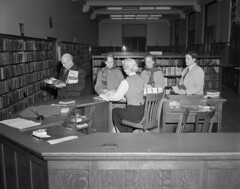Sunday, March 28, 2010
Evaluation of a "Wiki"
Tuesday, March 23, 2010
Using "The Commons"

City, public library - Originally uploaded by The Library of Virginia
As discussed in my previous post "The Commons" contains a variety of photos. The above photo is just one example of what can be found on the site. It is titled "City, public library" with the date of February 6, 1956. It can be found using through using the commons website. A direct link to the photo is http://www.flickr.com/photos/library_of_virginia/2899334394/
Flickr and the Library of Congress
Using Flickr
Monday, March 22, 2010
Evaluation of "Hey Jude" blog
O'Connell Judy, 2006 Hey Jude viewed 18/03/2010 http://www.heyjude.wordpress.com
Friday, March 19, 2010
"Hey Jude" Website
Using Technorati to choose a blog to evaluate
Sunday, March 14, 2010
Varifying this Blog
Hey Jude : Learning in an online world
Sunday, March 7, 2010
Articles on Copyright
The first was by Colin Steele with the article "Who will own what we read?" He spoke about a "revolution in communication unparalleled since the invention of the printing press in the 15th century". The article discusses access to information and who controls this information. It discusses the question of who will own Google ten years from now and the implication this may have. This question is raised as in January this year founders of Google Larry Page and Sergey Brin announced that between them they intend to sell 10 million shares in Google during the next five years.
Although Google scanned the works to index them the plaintiff said without the permission from the copyright owner, Google was a pirate.
Google settled the lawsuit (the settlement was 165 pages long). This allowed Google to "pay for the right to make up to 20 per cent of copyrighted books whose author could not be found available to the public for free; and beyond 20 per cent, the public could pay to access the full book, with the funds given over to a new non-profit body charged with getting these royalties to the authors who want them."

